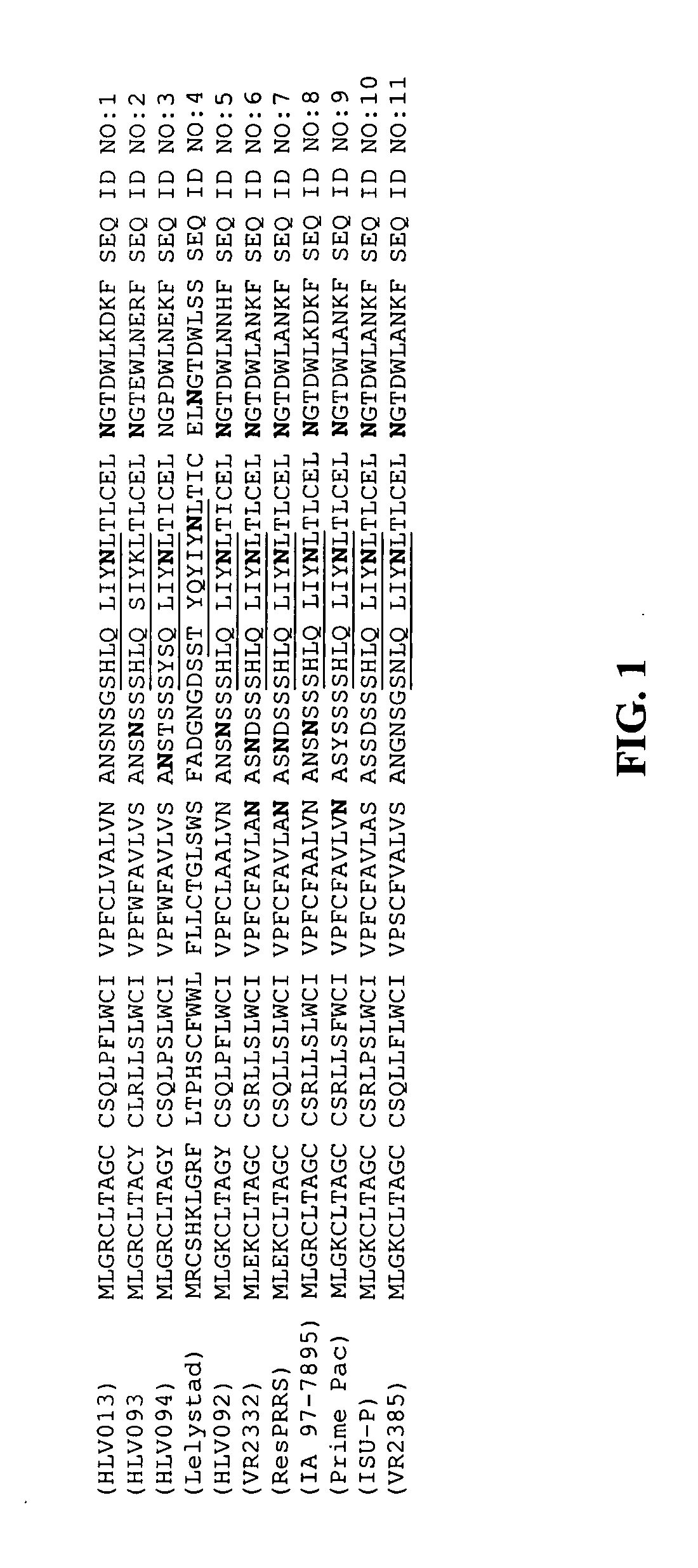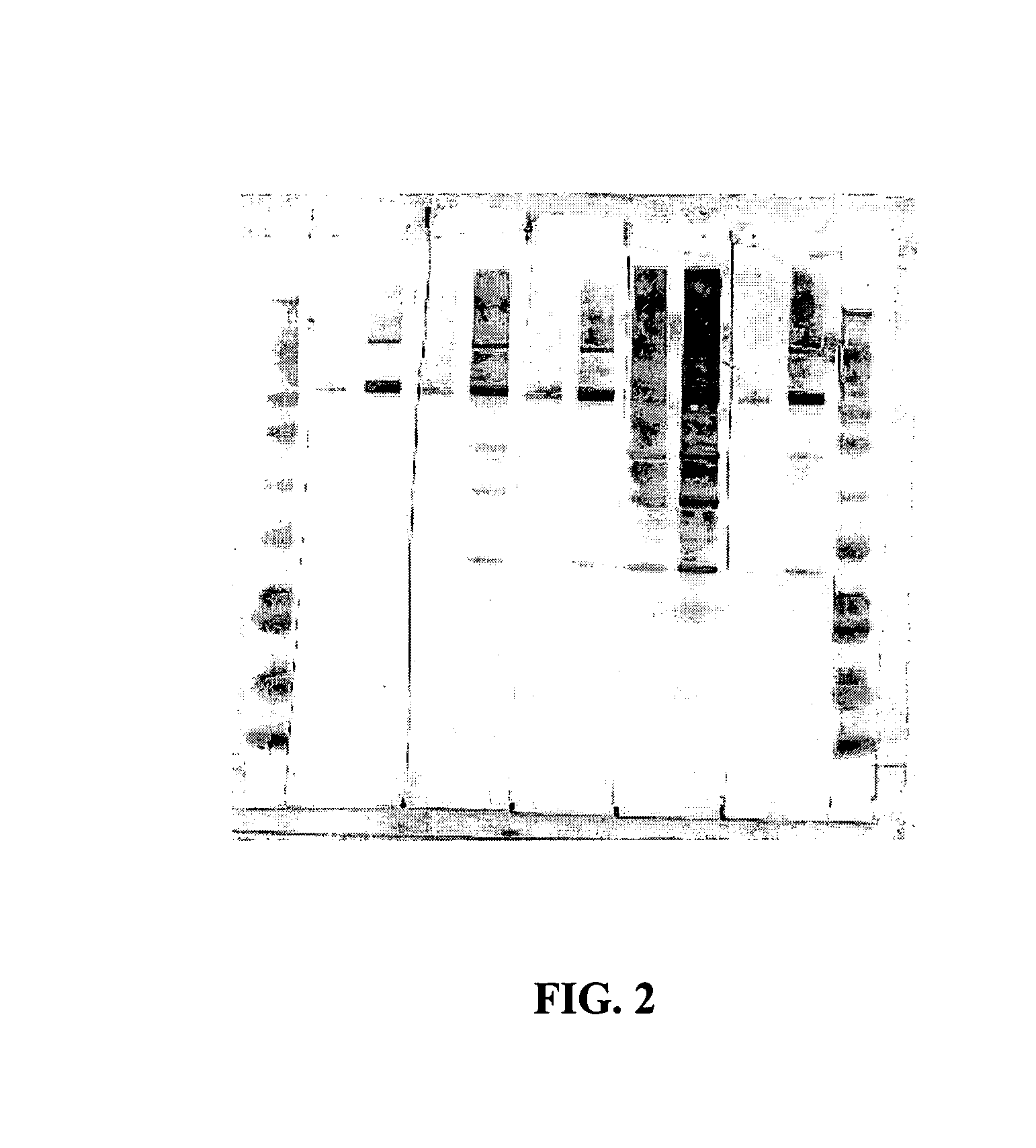Identification of protective antigenic determinants of porcine reproductive and respiratory syndrome virus and uses thereof
a technology antigen identification, which is applied in the field of identification of protective antigens of porcine reproductive and respiratory syndrome virus, can solve the problems of respiratory distress, rough hair coat, slow growth of affected piglets, etc., and achieve the effect of treating or preventing prrsv infection in a pig
- Summary
- Abstract
- Description
- Claims
- Application Information
AI Technical Summary
Benefits of technology
Problems solved by technology
Method used
Image
Examples
example 1
[0214] The solution to identification of the PAD of PRRSV was not obvious because others have not synthesized the information concerning North American and European strains of PRRSV and Equine Arteritis Virus (EAV) into knowledge. For example, the modified live vaccine (MLV) for EAV is very efficacious while the MLV for PRRSV is not. Thus many scientists apparently have concluded that a comparison of the similarities and differences between the two viruses would not be of value regarding the development of a vaccine for PRRSV. Beginning in early February 2005, the inventors studied numerous publications, synthesized the various important information, and by deductive reasoning identified the protective antigenic determinants of PRRSV as the Matrix-Glycoprotein 5 (M-GP5) heterodimer.
[0215] One of the most interesting and puzzling aspects of PRRS epidemiology is the variation between North American and European isolates and the fact that at least before introduction of PRRSV live vac...
example 2
[0225] Recent work in our lab showed that a live strain of PRRSV (FIG. 2, Strain HLV013) lacking the glycans prior to amino acid 44 of GP5 would induce high titers to the GP neutralizing epitope as determined by a neutralizing peptide ELISA assay. Further analysis of HLV013 via Western immunoblotting indicated a stronger, earlier antibody response to GP5 and GP5-M heterodimer when compared to VR2332 and sera from HLV013 infected pigs showed more cross-reaction with PRRSV strain IA97-7895 than did sera from VR2332 infected pigs (FIGS. 2 and 3). Results from these studies have led us to believe that N-glycosylation patterns in association with the GP5-M heterodimer are important components of a more effective neutralizing antibody response.
[0226] The influence of glycosylation on the evolution of neutralizing antibodies was first shown in this experiment. In this experiment, 3 groups of 6 PRRSV negative pigs were treated as shown in Table A. Pigs were inoculated on Day 0 and again on...
example 3
[0228] Animal inoculation: Two 2-3 week old pigs were obtained from a source with no detectable presence of PRRSV and housed at ISU research facilities. Following acclimatization, pigs were infected intranasally with 105 TC-ID50 of the desired strain. Pigs were bled on days −7, 0, 7, 21, 35, and 70 post-inoculation to allow adequate time for production of neutralizing antibodies followed by humane euthanasia. Sera was aliquoted and sent to ISU Diagnostic Lab for anti-N antibody ELISA (Herdcheck, IDEXX), SDSU Diagnostic Lab for MARC 145 serum neutralization assay (FFN), and University of Minnesota for neutralizing peptide ELISA (Plagemann). Remaining sera was used for inhibition of AM infection testing at ISU.
[0229] This experiment was conducted in order to further evaluate the ability of strains deficient in GP5 N-glycans to generate high titers of neutralizing antibodies and their cross-reactivity. Pigs negative for PRRSV were obtained and randomized into 3 groups as shown in Tabl...
PUM
| Property | Measurement | Unit |
|---|---|---|
| length of time | aaaaa | aaaaa |
| weight | aaaaa | aaaaa |
| weight loss | aaaaa | aaaaa |
Abstract
Description
Claims
Application Information
 Login to View More
Login to View More - R&D
- Intellectual Property
- Life Sciences
- Materials
- Tech Scout
- Unparalleled Data Quality
- Higher Quality Content
- 60% Fewer Hallucinations
Browse by: Latest US Patents, China's latest patents, Technical Efficacy Thesaurus, Application Domain, Technology Topic, Popular Technical Reports.
© 2025 PatSnap. All rights reserved.Legal|Privacy policy|Modern Slavery Act Transparency Statement|Sitemap|About US| Contact US: help@patsnap.com



